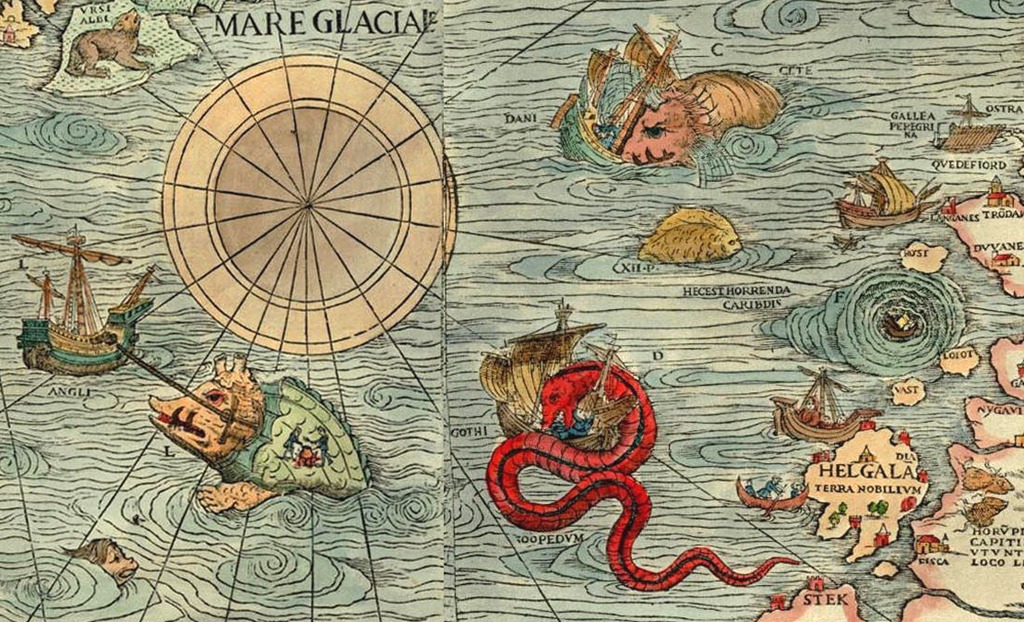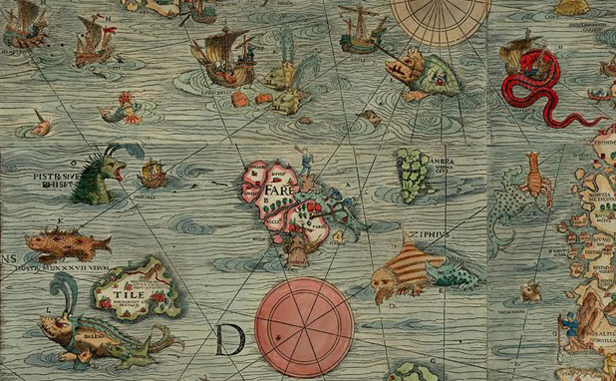Hic Sunt Dracones: Sea Monsters In Ancient Cartography
Several centuries ago the art of cartography included a parade of creatures that beautifully reflected the fears and beliefs of the time.
Of the vast spaces on the earth’s surface, the sky and the sea have been the chosen depths for explorers. The sky, crossed only by clouds during the day, has been and continues to be the most effective compass during the night when it is filled with constellations. For mariners, the sky ensured a route; for the first philosophers, it provided proofs and hypotheses on the astronomical dimensions of the universe; for mystics and the religious, it was an expression of divine will and a macrocosm, a guide to predict individual destines and even to diagnose illnesses. The ocean, its counterpart and mirror, has always been more threatening, perhaps because it has been more transited: the sea was for centuries a place of adventure and journeys; conquest, war and trade. Despite the familiarity with which mariners sailed the seas, their depths remained a mystery for centuries and, let’s face it, they remain so to this day.
Medieval and Renaissance cartography is a very interesting example of how fear of the unknown and that real danger that is the power of the natural elements were graphically projected in fantasy figures such as sea monsters. Placed on coasts or straits where the danger of shipwreck was very high (think of Scylla and Charybdis) or in unknown territories (terra incognita) or little-explored areas, sea monsters are at the same time exquisite decorative elements, imprecise zoological documents and indispensable elements to decipher a world view.
In some cases there was no pictorial representation of the monster, but there was a warning: hic sunt dracones (“here are dragons,”) an indication that can be read on some mapa mundi and that pointed out unknown seas. Cartography with fantastical beings even became a political-commercial strategy: on a map of the Norwegian Sea by Olaus Magnus from 1539, the Scandinavian peninsula appears surrounded by fearful creatures, a strategy to dissuade foreign fishermen from venturing into those lands and plundering the local fish.
Which monsters terrorized ancient shipping? Often they were creatures that today we would not classify as part of a bestiary, such as whales, dolphins and walruses, but as they were a rare sight in those days they were considered monstrous. Chet van Duzer highlights this fact: while monsters in cartography swim on the surface, and therefore reveal their full bodies, or at least show it to the extent that the rest can be easily imagined, the experience of navigators was much more diffuse and ephemeral, and as a result, terrifying; sea monsters on maps, were perfectly outlined, and are, strangely, a way of making the unknown familiar, apprehending the incomprehensible.
On other occasions, the creation of monsters by cartographers (it must be remembered that medieval maps were drawn by hand, to order, and the most outstanding were often exhibited as a sign of social status, more than used for navigation) and were based on theological precepts concerning the physiognomy of the animal kingdom. The idea that to each terrestrial being there corresponds a marine equivalent, expressed, for example, by the Roman naturalist Plinio, resulted in the abundance of hybrid beings (dog-fish, fish-hen, fish-lion and even fish-goat). This notion is perhaps also rooted in the creation of mythological beings, half human, half fish, such as mermaids and Triton; in the mid-16th century, the acute imagination of Giacomo Gastaldi pushes that hybridization to murkier territory, that of social stratification, with the insertion of aquatic monks and bishops in one corner of his Cosmographia Universalis et Exactissima iuxta postremam neotericorum traditionem, figures that would be reiterated by other contemporary artists and reproduced centuries later by scientists such as Gaspar Schott and Johann Zahn.
This brief journey through the diversity of creatures that populated ancient maps is clear evidence that curiosity surrounding the ocean depths was a constant in the history of humanity and has been broached from diverse angles; the unnerving and, at the same time, desired presence of sea monsters on medieval maps does not respond to a need to chart a physical territory but rather an intention to populate and elucidate the map of other landscapes impossible to locate geographically, those of our own psyche.
Related Articles
Pictorial spiritism (a woman's drawings guided by a spirit)
There are numerous examples in the history of self-taught artists which suggest an interrogation of that which we take for granted within the universe of art. Such was the case with figures like
Astounding fairytale illustrations from Japan
Fairy tales tribal stories— are more than childish tales. Such fictions, the characters of which inhabit our earliest memories, aren’t just literary works with an aesthetic and pleasant purpose. They
A cinematic poem and an ode to water: its rhythms, shapes and textures
Here lies One Whose Name was writ in Water. - John Keats Without water the equation of life, at least life as we know it, would be impossible. A growing hypothesis holds that water, including the
Watch beauty unfold through science in this "ode to a flower" (video)
The study of the microscopic is one of the richest, most aesthetic methods of understanding the world. Lucky is the scientist who, upon seeing something beautiful, is able to see all of the tiny
To invent those we love or to see them as they are? Love in two of the movies' favorite scenes
So much has been said already, of “love” that it’s difficult to add anything, much less something new. It’s possible, though, perhaps because even if you try to pass through the sieve of all our
This app allows you to find and preserve ancient typographies
Most people, even those who are far removed from the world of design, are familiar with some type of typography and its ability to transform any text, help out dyslexics or stretch an eight page paper
The secrets of the mind-body connection
For decades medical research has recognized the existence of the placebo effect — in which the assumption that a medication will help produces actual physical improvements. In addition to this, a
The sea as infinite laboratory
Much of our thinking on the shape of the world and the universe derives from the way scientists and artists have approached these topics over time. Our fascination with the mysteries of the
Sharing and collaborating - natural movements of the creative being
We might sometimes think that artistic or creative activity is, in essence, individualistic. The Genesis of Judeo-Christian tradition portrays a God whose decision to create the world is as vehement
John Malkovich becomes David Lynch (and other characters)
John Malkovich and David Lynch are, respectively, the actor and film director who’ve implicitly or explicitly addressed the issues of identity and its porous barriers through numerous projects. Now












